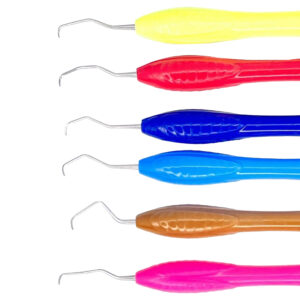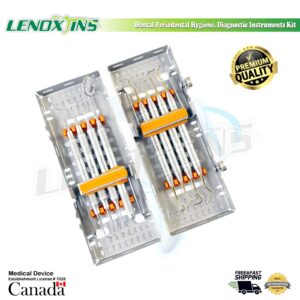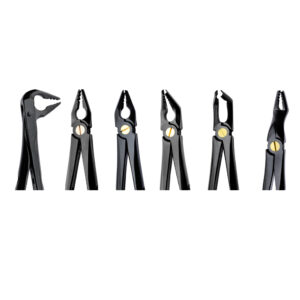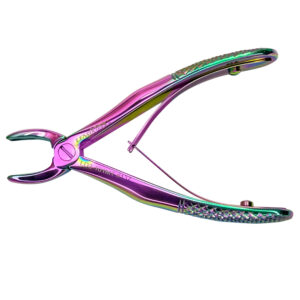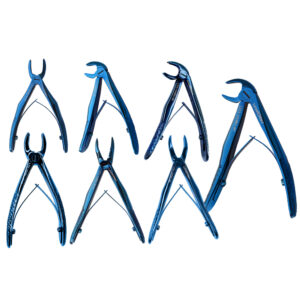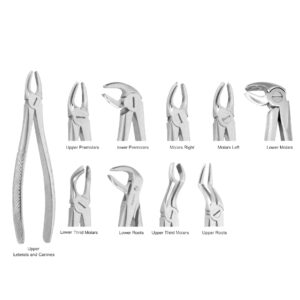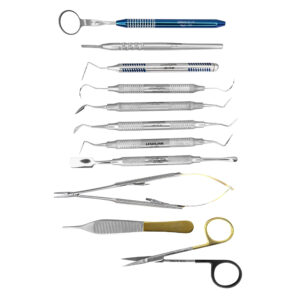Choosing the Perfect Sickle Scaler: A Guide for Dental Professionals
- Posted October 10, 2024
- by LENOX INC CANADA
Selecting the right sickle scaler can significantly impact dental practice outcomes. Many professionals struggle to choose the best tool for effectively scaling teeth and managing patient discomfort. This guide will outline essential factors to consider, such as aligning scaler choice with clinical needs and evaluating various brands and models. Readers will gain practical insights into selecting a sickle scaler that enhances their hand skills while ensuring optimal care for patients’ gums. By addressing common challenges faced in the selection process, this content aims to simplify decision-making and improve patient results.
Links:
Key Takeaways
- Selecting the right sickle scaler enhances plaque removal and patient comfort during dental procedures
- Ergonomic designs reduce strain, improving practitioner efficiency and overall patient care quality
- Material choice, like stainless steel or titanium, impacts durability and effectiveness in dental hygiene practices
- Regular maintenance, including sharpening and inspections, extends the lifespan of sickle scalers significantly
- Understanding patient needs and oral conditions aids in selecting the most effective scaler design
Understanding Sickle Scalers in Dental Practice
Sickle scalers are essential tools in dental hygiene, specifically designed for effective plaque removal around the molars and other teeth. This section will explore different types of sickle scalers, their common clinical applications, and techniques for optimal use. Understanding these instruments can enhance patient care by promoting healthier mouth tissue and improving overall hygiene practices.
Exploring Different Types of Sickle Scalers
sickle scalers are available in various designs, each tailored for specific dental procedures. The classic sickle scaler, often made from stainless steel, features a pointed blade ideal for utilizing a firm stroke to remove plaque from the tooth surface, particularly around the anterior teeth. In contrast, some models are designed with curved blades that facilitate access to deeper periodontal pockets, ensuring comprehensive cleaning during professional dental hygiene appointments.
Common Clinical Applications and Techniques
Sickle scalers play a crucial role in various dental procedures, particularly in the effective removal of calculus from tooth surfaces. Dental professionals often utilize these instruments at a specific angle to maximize their efficiency, allowing for precise access to areas that require thorough cleaning. The choice of materials, such as titanium, can further enhance performance, providing durability while reducing the risk of corrosion during use. Mastering the techniques associated with sickle scalers not only improves the quality of patient care but also promotes better oral health outcomes.
Benefits of Incorporating Sickle Scalers
Incorporating sickle scalers into dental hygiene practices offers significant advantages for both practitioners and patients. These dental instruments, when used correctly, enable effective debridement of calculus and plaque, ensuring a cleaner oral environment. The ergonomic design of sickle scalers allows for enhanced wrist positioning, reducing strain during lengthy procedures and promoting precision in cleaning hard-to-reach areas, thus elevating the overall quality of dental care. sickle scaler 204S 440C
Choosing the right sickle scaler is crucial for effective dental care. Next, the article will explore the essential factors that guide this important decision.
Essential Factors When Selecting a Sickle Scaler
Essential Factors When Selecting a Sickle Scaler
When choosing a sickle scaler, dental professionals must consider several vital factors. Assessing blade design and efficiency is crucial for effective plaque removal, especially around the posterior teeth. Handle ergonomics significantly impact comfort during procedures, while material selection, particularly steel, is important for durability and performance. Additionally, maintenance and sterilization practices are essential for ensuring the longevity and safety of the instrument.
Assessing Blade Design and Efficiency
Assessing the blade design and efficiency of sickle scalers is critical for dental professionals who prioritize effective plaque removal during hygiene practices. A scaler with a sharp, pointed blade enables precise access to tight areas, such as between molars, while a curved design can effectively navigate deeper pockets. Selecting the appropriate blade design not only enhances the quality of dental care but also reduces the time spent on procedures, thereby improving patient satisfaction and outcomes. Sickle Scaler
Importance of Handle Ergonomics for Comfort
The handle ergonomics of a sickle scaler significantly influence a dental professional’s comfort and efficiency during procedures. An ergonomic design minimizes wrist strain and enhances grip, allowing practitioners to maintain precision in their movements over extended periods. Selecting a scaler with a well-balanced handle can also lead to improved control and reduced fatigue, ultimately contributing to better patient outcomes and satisfaction.
Material Selection for Durability and Performance
The choice of material for sickle scalers significantly impacts their durability and performance in dental practice. Stainless steel is a common selection due to its strength and resistance to corrosion, ensuring longevity even with regular sterilization. Some dental professionals may opt for titanium scalers, which are lightweight and offer increased flexibility, making them easier to handle during intricate procedures. The right material not only promotes the effectiveness of plaque and calculus removal but also supports the overall hygiene standards essential for patient care: sickle scaler 204s 440c
- Stainless steel offers durability and corrosion resistance.
- Titanium provides lightweight handling and flexibility.
- Material choice impacts hygiene and effectiveness in procedures.
Maintenance and Sterilization Considerations
Proper maintenance and sterilization of sickle scalers are critical for ensuring their longevity and effectiveness in dental practice. Dental professionals should routinely inspect scalers for wear and damage, as any imperfections can compromise their performance and patient safety. Additionally, adhering to established sterilization protocols, such as autoclaving, is essential to eliminate pathogens, thereby promoting a safe environment for both the practitioner and the patient. Understanding these maintenance and sterilization considerations can significantly enhance the overall efficiency of dental hygiene practices and contribute to optimal patient care.
Selecting the right sickle scaler requires an understanding of specific clinical needs. In the next section, the focus shifts to how these choices align with effective patient care.
Aligning Scaler Choice With Clinical Needs
Selecting the appropriate sickle scaler is essential for dental professionals, as it directly impacts the effectiveness of specific dental procedures. Key considerations include enhancing patient comfort and safety during treatments, along with the scaler’s adaptability to various oral conditions. Each of these factors contributes significantly to achieving optimal clinical outcomes and overall patient satisfaction.
Selecting Instruments for Specific Dental Procedures
Selecting the appropriate sickle scaler for specific dental procedures is critical for ensuring effective plaque and calculus removal. Dental professionals must consider the unique requirements of each procedure, such as the accessibility of the site and the type of tissue involved. For instance, using a sickle scaler with a fine, pointed blade is ideal for anterior teeth, whereas a curved blade can better access molars and deeper periodontal pockets, enhancing the overall effectiveness of dental hygiene practices.
Enhancing Patient Comfort and Safety
Enhancing patient comfort and safety is paramount when selecting a sickle scaler. Dental professionals should prioritize scalers designed with ergonomic handles to reduce patient discomfort during procedures, allowing for better engagement and cooperation. Furthermore, choosing a scaler with a balanced weight and a comfortable grip can minimize unnecessary pressure on the patient‘s gums, thus supporting a more positive treatment experience.
- Focus on ergonomic handle design for improved comfort.
- Balanced weight aids in reducing strain during procedures.
- Enhancing comfort leads to better patient cooperation.
Adaptability to Various Oral Conditions
Adaptability is a crucial factor when selecting a sickle scaler, as various oral conditions may require different approaches to plaque and calculus removal. Dental professionals should consider the specific needs of their patients, such as the presence of periodontal disease or the tight spacing between teeth. For example, a scaler with a finely tapered blade can effectively navigate the challenging contours of molars or reach deeper pockets in periodontal areas, enhancing the overall effectiveness of dental treatments.
| Oral Condition | Recommended Sickle Scaler Features |
|---|---|
| Periodontal Disease | Curved blades for deeper access |
| Tight Spacing between Teeth | Finely tapered blades for precision |
| General Plaque Removal | Standard pointed blades for routine cleaning |
The choice of scaler influences treatment effectiveness. Next, a careful look at the brands and models reveals what truly matters in practice.
Evaluating Brands and Models of Sickle Scalers
Evaluating Brands and Models of Sickle Scalers
Understanding the variety of sickle scalers available requires an examination of leading manufacturers and their innovative features. This section will address how to balance cost with quality and value, along with insights gleaned from dental professional reviews. By exploring these elements, dental professionals can make informed choices that enhance their clinical practice and patient care. sickle scalers
Overview of Leading Manufacturers
Several leading manufacturers set the standard for high-quality sickle scalers in dental practice. Brands such as Hu-Friedy, American Eagle Instruments, and NSK are recognized for their commitment to innovation and precision in instrument design. Dental professionals often rely on these manufacturers due to their reputation for producing durable scalers that enhance efficiency and patient care, ensuring that practitioners can perform effective plaque removal with confidence.
Innovative Features in Modern Scalers
Modern sickle scalers come equipped with innovative features that enhance their functionality and usability in dental practices. Many brands now incorporate ergonomic handles designed to provide a better grip and reduce strain during procedures, which is essential for maintaining precision and comfort over extended periods. Additionally, advancements in materials, such as lightweight titanium and corrosion-resistant stainless steel, not only ensure durability but also enable practitioners to navigate challenging areas more effectively, ultimately improving patient care and satisfaction.
Balancing Cost With Quality and Value
When selecting a sickle scaler, dental professionals must evaluate the delicate balance between cost, quality, and overall value. While lower-priced models may seem appealing, investing in high-quality scalers from reputable brands often yields better long-term performance and patient outcomes. Practitioners should consider factors such as durability and effectiveness in plaque removal, as these tools directly impact clinical efficiency and patient satisfaction.
| Criteria | Considerations |
|---|---|
| Cost | Evaluate initial price versus long-term investment benefits. |
| Quality | Look for scalers made from durable materials for enhanced performance. |
| Value | Analyze the overall return on investment from using reliable brands. |
Insights From Dental Professional Reviews
Reviews from dental professionals often highlight the importance of reliability and ease of use in sickle scalers. Many practitioners emphasize that scalers with ergonomic handles significantly reduce fatigue during procedures, allowing for improved precision. Additionally, first-hand experiences shared by users can shed light on the durability and performance of various brands, aiding others in making informed decisions that directly impact patient care.
Having explored various brands and models of sickle scalers, the focus now shifts to their effective use. Understanding best practices for care and operation can enhance their performance and longevity.
Best Practices for Using and Caring for Sickle Scalers
Effective scaling procedures rely on mastering specific techniques, understanding routine sharpening and maintenance tips, and recognizing methods to prolong the lifespan of sickle scalers. This section will cover essential practices that ensure optimal performance over time, allowing dental professionals to maintain high standards of care and maximize the utility of their instruments.
Techniques for Effective Scaling Procedures
Effective scaling procedures begin with the correct angling of the sickle scaler, allowing dental professionals to maximize plaque removal while minimizing tissue trauma. Engaging in a systematic approach, such as starting from the gum line and moving towards the incisal edge, ensures thorough cleaning of the tooth surfaces. Additionally, consistent monitoring for fatigue and adjusting grip technique can enhance precision and reduce the risk of ergonomic strain during lengthy sessions.
Routine Sharpening and Maintenance Tips
Routine sharpening and maintenance of sickle scalers are essential practices that directly impact their effectiveness in plaque and calculus removal. Dental professionals should implement a consistent schedule for sharpening, using appropriate sharpening tools to maintain the blade’s sharpness and precision. Regularly inspecting scalers for wear and damage will ensure they operate effectively, thereby enhancing patient care and maintaining high hygiene standards.
| Maintenance Task | Description |
|---|---|
| Routine Sharpening | Sharpen blades periodically using proper tools to maintain effectiveness. |
| Visual Inspection | Check for wear and tear after each use to ensure optimal performance. |
| Proper Storage | Store scalers in a protective case to prevent damage and contamination. |
Prolonging Instrument Lifespan
To prolong the lifespan of sickle scalers, dental professionals should adhere to routine maintenance and proper handling techniques. Regularly inspecting the scalers for wear, ensuring that sharpening is performed with appropriate tools, and storing them correctly in protective cases can significantly enhance their durability. Practicing these essential care steps not only ensures effective performance but also supports a hygienic environment for patient care:
- Routine inspections for wear and damage.
- Consistent sharpening schedule with proper tools.
- Proper storage in protective cases.
Ensuring Optimal Performance Over Time
To ensure optimal performance over time, dental professionals must implement consistent maintenance practices for their sickle scalers. Regular inspections for wear and damage are critical, as any imperfections can hinder their effectiveness and potentially affect patient safety. Maintaining a structured schedule for sharpening and proper storage techniques can significantly extend the lifespan of these instruments, allowing practitioners to deliver high-quality care consistently.
| Maintenance Task | Description |
|---|---|
| Routine Inspections | Regularly check for wear and damage to maintain effectiveness. |
| Consistent Sharpening | Sharpen blades as needed using proper tools to retain sharpness. |
| Secure Storage | Store scalers in a protective case to prevent damage and contamination. |
Now that the nuances of care and handling have been covered, it’s time to focus on making an informed decision. Understanding the features that matter can lead to the right choice for your practice.
Finalizing Your Sickle Scaler Selection
Choosing the appropriate sickle scaler involves careful consideration of critical aspects such as sourcing reliable dental instruments, understanding warranties and customer support options, and planning for future practice requirements. Each of these elements plays a vital role in enhancing efficiency and effectiveness in dental procedures, ensuring that dental professionals are well-prepared to deliver optimal patient care. sickle scaler
Sourcing Reliable Dental Instruments
Sourcing reliable dental instruments, including sickle scalers, is crucial for maintaining high standards of care in dental practice. Dental professionals should prioritize suppliers known for their quality assurance and innovative instrument designs, as this ensures that the tools used meet clinical requirements. By selecting reputable manufacturers with positive reviews and proven track records, practitioners can enhance their efficiency in plaque removal and ensure patient satisfaction through effective treatment outcomes.
Understanding Warranties and Customer Support
Understanding warranties and customer support is critical for dental professionals when selecting a sickle scaler. A comprehensive warranty often indicates a manufacturer’s confidence in their product’s durability and reliability, providing peace of mind in case of defects. Additionally, responsive customer support can assist practitioners with any product-related issues or inquiries, ensuring they receive timely solutions that facilitate optimal use of their instruments.
Planning for Future Practice Requirements
Planning for future practice requirements involves assessing the anticipated growth and evolving needs of a dental practice. Dental professionals should consider factors such as expanding patient demographics and advancements in oral care technologies, which may necessitate an adaptation in the types of sickle scalers employed. By investing in versatile and durable instruments today, practitioners can ensure they are equipped to meet the challenges of tomorrow’s dental landscape while maintaining high standards of patient care.
Conclusion
Selecting the right sickle scaler is crucial for dental professionals aiming to enhance patient care and achieve optimal clinical outcomes. Understanding factors such as blade design, handle ergonomics, and material durability plays a vital role in ensuring effective plaque and calculus removal. Prioritizing maintenance and proper instrument handling can significantly extend the lifespan of these tools, contributing to a hygienic practice environment. By making informed choices in sickle scalers, practitioners not only improve their efficiency but also pave the way for better patient experiences and satisfaction.











